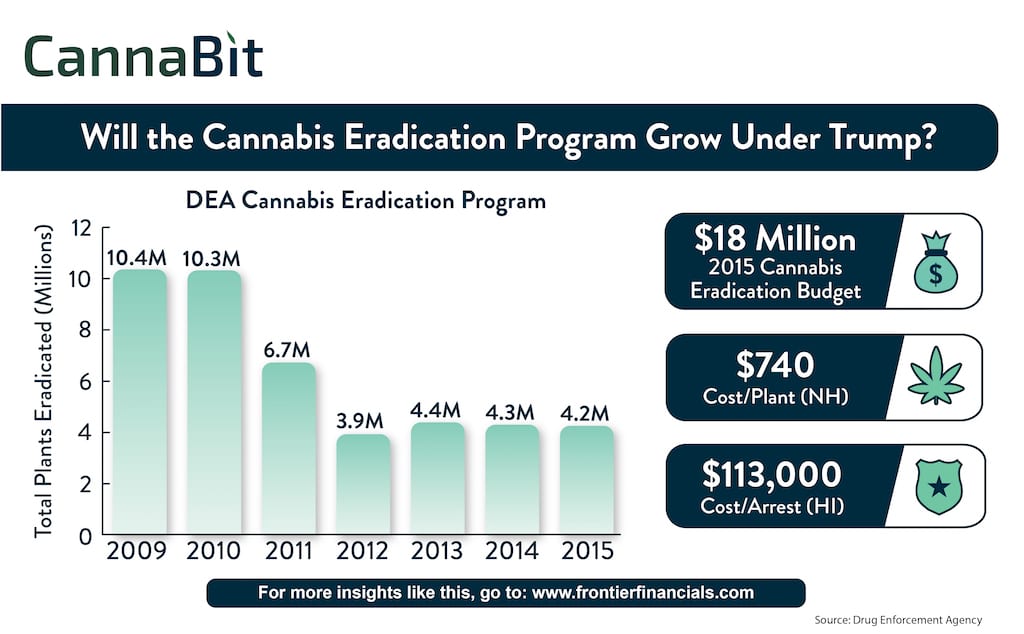Will the Cannabis Eradication Program Grow Under Trump?


Despite Mixed Results, Will DEA’s Cannabis Eradication Program Grow under Trump?
The Trump administration’s policy toward cannabis remains unclear and among the questions still to be addressed is how the Drug Enforcement Administration may change its cannabis eradication efforts. Since 2009, the number of plants destroyed under the Cannabis Eradication Program has fallen nearly 60% from over 10.3 million to 4.3 million plants in 2015. The decline has been in part due to Congressional cuts to DEA’s budget as well as limits lawmakers placed on DEA’s targeting of businesses operating in states which have legalized medical cannabis.
The DEA’s cannabis eradication program, which had a budget of $18 million in 2015, was most recently thrust into the spotlight following the revelation that in 2015 the agency spent $70,000 on eradication in Utah but did not find a single illegally grown plant. While the unsuccessful efforts in Utah raised questions about the program’s return on investment, eradication efforts were more successful in other states. In California, 2.6 million plants were destroyed, which accounted for 62% of the 4.3 million plants targeted nationally. Kentucky had the second highest number of eradications, with over 570,000 plants destroyed.
The number of plants destroyed nationally is dwarfed by the volume of cannabis being produced legally in states with medical and adult use programs. Nationally, the DEA eradicated 4.3 million plants in 2015. This stands in contrast to the 6.6 million plants grown in the Colorado’s legal cannabis industry alone. The strong growth in demand for legally produced cannabis has underscored how implementation of adult use markets can erode demand for illicit cannabis, driving down illicit production and reducing the need for enforcement activity.
Arrests are Down Significantly but Asset Seizures are Falling More Slowly
Under the eradication program, over 53,000 people have been arrested since 2009, but here too the numbers have declined significantly, falling by 38% from over 10,000 arrests in 2009 to under 6,300 in 2015. The cost per arrests vary widely nationally. Hawaii had the highest average cost per arrest at nearly $113,000 compared to a national average of $7,800 per arrest.
The one aspect of the program which has not declined as steeply is the value of the assets seized under eradication program. The agency has seized over $232 million in assets since 2009. Seizures have fallen from $37.3 million in 2009 to $29.7 million in 2015, a 20% decline. Civil asset forfeiture – the practice by which the government can seize assets from anyone suspected of acquiring assets with the proceeds from illegal activity – has been an important source of funding for federal and state law enforcement agencies, and it continues to be widely applied in cannabis-related cases even when other enforcement activities may be declining.
The question on how the eradication program might evolve under the new administration is of particular interest given the President’s aggressive stance on drug enforcement. Speaking in early February 2016, the president said, “We’re going to stop [illegal] drugs from poisoning our youth, from poisoning our people. We’re going to be ruthless in that fight. We have no choice.” These statements, coupled with new Attorney General Jeff Sessions’ strong support for civil asset forfeiture as a law enforcement tool suggest that there may be renewed appetite for cannabis prohibition enforcement under the new administration, despite the program’s mixed results nationally. However, the need for the program may decline over time as more states legalize adult use thereby eroding demand for illegally produced cannabis.


